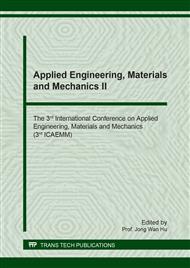[1]
M. Klessinger, The origin of the colour of indigo dyes. Dye. Pigm. 3(2-3) (1982) 235-241.
Google Scholar
[2]
A. H. Said, W. Miled, N. Ladhari, et al. New Prospects in the Electrochemical Dyeing of Indigo. J. Appl. Sci. 8(13) (2008) 2456-2461.
DOI: 10.3923/jas.2008.2456.2461
Google Scholar
[3]
A. Roessler, X. Jin. State of the art technologies and new electrochemical methods for the reduction of vat dyes. Dye. Pigm. 59(3) (2003) 223-235.
DOI: 10.1016/s0143-7208(03)00108-6
Google Scholar
[4]
M. A. Kulandainathan, A. Muthukumaran, K. Patil, et al. Potentiostatic studies on indirect electrochemical reduction of vat dyes. Dye. Pigm. 73(1) (2007) 47-54.
DOI: 10.1016/j.dyepig.2005.10.007
Google Scholar
[5]
A. Vuorema, P. John, M. Keskitalo, et al. Electrochemical and sonoelectrochemical monitoring of indigo reduction by glucose. Dye. Pigm. 76(2) (2008) 542-549.
DOI: 10.1016/j.dyepig.2006.06.044
Google Scholar
[6]
T. X. H. Le, M. Bechelany, S. Lacour, et al. High removal efficiency of dye pollutants by electron-Fenton process using a graphene based cathode. Carbon, 94 (2015) 1003-1011.
DOI: 10.1016/j.carbon.2015.07.086
Google Scholar
[7]
W. Miled, N. Ladhari, A. H. Said, et al. Indirect electrochemical reduction of vat dyes process optimization for indigoid, anthraquinonic and polycyclic vat. Int. Rev. Chem. Eng. Rap. Commun. 2(1) (2010) 3-9.
Google Scholar
[8]
R. B. Chavan, J. N. Chakraborty. Dyeing of cotton with indigo using iron(II) salt complexes. Colorat. Tech. 117(2) (2006) 88-94.
DOI: 10.1111/j.1478-4408.2001.tb00340.x
Google Scholar
[9]
A. Roessler, D. Crettenand. Direct electrochemical reduction of vat dyes in a fixed bed of graphite granules. Dyes Pigm. 63(1) (2004) 29-37.
DOI: 10.1016/j.dyepig.2004.01.005
Google Scholar
[10]
H. F. Mansour. Environmental production of fashion colors from natural dyes. Int. J. Phys. Sci. 8(16) (2013) 670-683.
DOI: 10.5897/ijps12.665
Google Scholar
[11]
B. Thomas, T. Aurora. Iron-complexes of bis(2-hydroxyethyl)-amino-compounds as mediators for the indirect reduction of dispersed vat dyes – Cyclic voltammetry and spectroelectrochemical experiments. J. Electroanal. Chem. 591(1) (2006) 118-126.
DOI: 10.1016/j.jelechem.2006.03.040
Google Scholar
[12]
T. Bechtold, A. Turcanu. Fe3+ --gluconate and Ca2+ -Fe3+ --gluconate complexes as mediators for indirect cathodic reduction of vat dyes – Cyclic voltammetry and batch electrolysis experiments. J. Appl. Electrochem. 34(12) (2004) 1221-1227.
DOI: 10.1007/s10800-004-1707-z
Google Scholar
[13]
T. Bechtold, E. Burtscher, A. Turcanu. Ca2+–Fe3+–D-gluconate-complexes in alkaline solution. Complex stabilities and electrochemical properties. J. Chem. Soc: Dalton Trans, 43(13) (2002) 2683-2688.
DOI: 10.1039/b202086f
Google Scholar
[14]
Y. Xu, H. Li, C. Chu, et al. Indirect Electrochemical Reduction of Indigo on Carbon Felt: Process Optimization and Reaction Mechanism. Ind. Eng. Chem. Res, 53(26) (2014) 10637-10643.
DOI: 10.1021/ie500603y
Google Scholar


